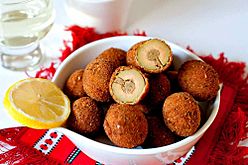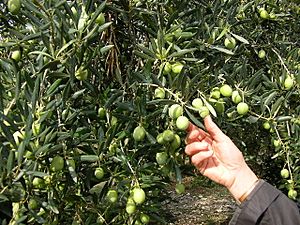Olive all'ascolana facts for kids

Olive all'ascolana
|
|
| Course | Appetizer |
|---|---|
| Place of origin | Italy |
| Region or state | Marche |
| Serving temperature | Hot |
| Main ingredients | Olives, meat, soffritto, breadcrumbs, cheese |
Olive all'ascolana (also called olive ascolane ripiene) means "stuffed olives from Ascoli." It is a yummy Italian appetizer made of olives that are filled with meat and then fried.
Contents
History of Olive all'ascolana
This special dish was first made around the year 1800 in a place called Ascoli Piceno in the Marche region of Italy. It was created by chefs who worked for rich families. They wanted to use up any leftover meat from big parties or celebrations.
Today, you can find Olive all'ascolana served as a snack in bars, often with drinks. It's also a popular treat at festivals, where it's served in paper cones. A famous food writer, Mimi Sheraton, even wrote about this dish in her book 1,000 Foods to Eat Before you Die in 2015.
How Olive all'ascolana is Made
The traditional way to make this dish uses a special type of green olive called Ascolano. Chefs carefully cut the olive in a spiral shape to remove the pit, then wrap the olive around a small ball of meat. Nowadays, many recipes use olives that already have their pits removed.
The meat filling is usually a mix of different kinds, like veal, beef, pork, or chicken. This meat is first cooked with a mix of chopped vegetables called soffritto. Then, it's simmered in white wine, ground up, and mixed with cheese, like Parmigiano-Reggiano or Grana Padano. Some recipes add spices like nutmeg, garlic, or red chili flakes. Sometimes, the olives are even stuffed with sweet Italian sausage or fish, especially in areas near the coast.
After being stuffed, the olives are rolled in egg and breadcrumbs. Finally, they are deep-fried until they are golden and crispy.
You can enjoy these olives on their own or with a slice of lemon. They are sometimes served with other fried foods, like sage, lamb chops, or custard. Olive all'ascolana tastes great with dry, crisp white wines, such as Verdicchio or Pinot Blanc.
Oliva Ascolana del Piceno: A Special Olive
The “Oliva Ascolana del Piceno DOP” is a very special food from the Piceno area in the Marche region. "DOP" stands for "Protected Designation of Origin." This means it's a unique product that can only come from this specific area. The name refers to olives that are either kept in salty water (brine) or stuffed. They are made from a specific type of olive tree called “Ascolana Tenera.”
This special olive is popular in Italy and other countries. It received its protected status from European law in 2005. A group was even formed in 2018 to help protect and promote it.
What "Oliva Ascolana" Means
The name comes from the Italian word oliva, which means "olive." The word ascolana refers to the city of Ascoli Piceno, where this olive originally comes from.
Special Features of the Olive
The large green “Ascolana Tenera” olive is a type of Olea europaea sativa. People have known about it since the time of Ancient Rome! Locally, it's also called Liva da Concia, Liva Ascolana, or Liva di San Francesco. These olives are loved because they are crunchy and have a lot of pulp.
They are picked before they are fully ripe. Then, they are soaked in a special solution to make them less bitter. After that, they are washed and put into salty water (brine) to keep them fresh.
For the stuffed olives, the process is similar. First, the olives are prepared. Then, their pits are removed, and they are filled with minced meat. Finally, they are deep-fried in oil. They can be served alone or with other fried foods like lamb cutlets, zucchinis, artichokes, or cream. This mix is called fritto misto all’ascolana (Ascoli mixed fried). They are often served hot, sometimes with lemon slices. It's a classic dish for parties and special events.
You can tell if the olives are handmade because they have a spiral shape after the pit is removed. This cut is called "ricciolo," meaning "curl." There are also strict rules about the ingredients for the DOP version. For example, beef cannot be more than 70% of the meat, pork cannot be more than 50%, and chicken cannot be more than 10%. Also, the olive without its pit must be at least 40% of the final weight of the stuffed olive.
A Look Back at History
The ancient Romans called these olives Ulivae Picenae. They also called them colymbades, which means "to swim" in Greek. This name came from how they were kept in brine. Famous Roman writers like Cato the Elder, Marcus Terentius Varro, Martial, and Petronius wrote about them. Petronius even described them as a regular food on the table of a character named Trimalchio.
Even after the Roman Empire fell, the olive business continued. During the Middle Ages, it was an important activity for local Olivetan monks. In the 1500s, Pope Sixtus V, who was born in the Piceno region, wrote about these olives in a letter. About a hundred years later, people started making the first kind of stuffed olives. Back then, they were filled with herbs and called olive giudee (Jewish olives).
The recipe we know today came about in the 1800s from the homes of rich families in Ascoli. These noble families owned a lot of land, and their farmers would regularly bring them products, especially meat. To make sure the large amounts of beef and pork didn't spoil, the cooks in these mansions started mincing the meat and putting it inside the olives.
Around the same time, famous musicians like Gioachino Rossini and Giacomo Puccini also loved the Ascolana olive. Even Giuseppe Garibaldi, a famous Italian general, tried this dish when he visited Ascoli Piceno in 1849. He was so impressed that he later tried to plant the olive trees on his island, Caprera, but it didn't work out. For a long time, making these olives was a family or small craft activity. But in 1875, an engineer named Mariano Mazzocchi started the first factory to sell the product more widely.
Local Events
Since 2013, the “Ascoliva Festival" has been held every August in Ascoli Piceno. This festival helps promote the Ascolana olive and other local foods. It has many stands where small producers offer different local specialties. You can taste the food and learn about its history and connection to the area. The festival takes place in the city's historic main square, Piazza Arringo.


